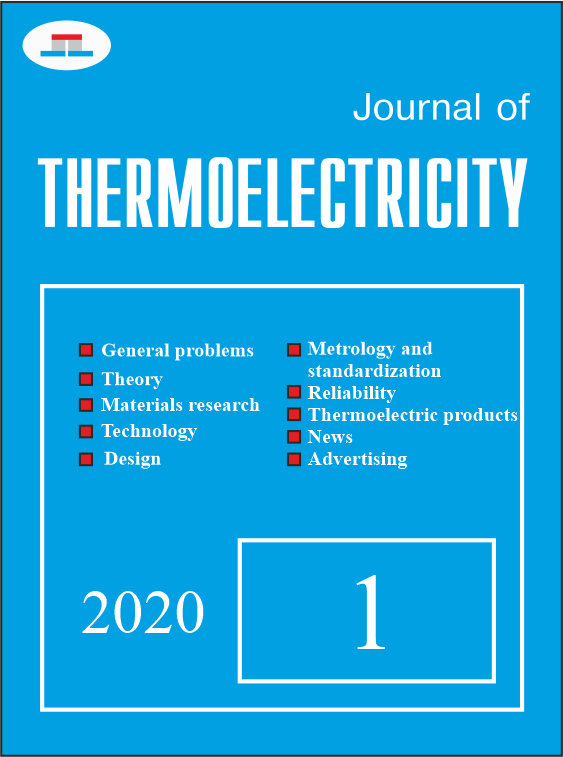Optimal control of transient thermoelectric cooling process in the mode of minimum power consumption
DOI:
https://doi.org/10.63527/1607-8829-2020-1-61-75Keywords:
transient thermoelectric cooling, optimal control, optimal time dependences of thermoelement supply currentAbstract
The problem of optimal control of transient thermoelectric cooling process in the mode of minimum power consumption is formulated and a method for its solution is proposed. An algorithm and a computer tool have been developed, which are used to calculate the optimal time dependences of the thermoelement supply current, whereby a given cooling temperature is reached within a given time with minimum power consumption. Examples of computer simulation of such optimal control functions for transient cooling process are given. It has been established that energy saving when supplying thermoelements with an optimally time-dependent current reaches 25 – 50 % in comparison with the option of direct current power supply. Bibl. 29 , Fig. 5, table 1.
References
Stilbans L.S., Fedorovich N.A. (1958). O rabote okhlazhdaiuschchikh termoelementov v nestatsionarnom rezhime [On the work of cooling thermoelements in transient mode]. Zhurnal tekhnicheskoi fiziki – Technical Physics, 28(3), 12–15 [in Russian].
Parrott J.E. (1960). The interpretation of stationary and transient behaviour of refrigerating thermocouples. Solid-State Electronics, 1 (2), 135–143.
Babin V.P., Iordanishvili E.K. (1969). O povyshenii effekta termoelektricheskogo okhlazhdeniia pri rabote termoelemntov v nestatsionarnom rezhime [Increasing thermoelectric cooling effect with the work of thermoelements in transient mode]. Zhurnal tekhnicheskoi fiziki – Technical Physics, 39(2), 399–406 [in Russian].
Landeсker K., Findley A.W. (1961). Study of transient behavior of Peltier junctions. Solid-State Electronics, 3(3-4), 239–260.
Hoyos, G. E., Rao K.R., Jerger D. (1977). Fast transient response of novel Peltier. Energy Conversion, 17(1), 45–54.
Grinberg G.A. (1968). O nestatshionarnom rezhime raboty okhlazhdaiushchikh termoelementov [On the transient operating mode of cooling thermoelements]. Zhurnal tekhnicheskoi fiziki – Technical Physics, 38(3), 418–424 [in Russian].
Rivkin A.S. (1973). Optimalnoiie upravleniie nestatsionarnym processom termoelektricheskogo okhlazhdeniia [Optimal control of the transient process of thermoelectric cooling]. Zhurnal tekhnicheskoi fiziki – Technical Physics, 43(7), 1563–1570.
Idnurm, M., Landecker K. (1973). Experiments with Peltier junctions pulsed with high transient currents. Journal of Applied Physics, 34(6), 1806–1810.
Field, R. L., Blum H.A. (1979). Fast transient behavior of thermoelectric coolers with high current pulse and finite cold junction. Energy Conversion, 19(3), 159–165.
Snyder G. J., Fleurial J.-P., Caillat T., Yang R.G., Chen G.J. (2002). Supercooling of Peltier cooler using a current pulse. Journal of Applied Physics, 92(3), 1564–1569.
Shen L. M., Xiao F., Chen H.X., Wang S.W. (2012). Numerical and experimental analysis of transient supercooling effect of voltage pulse on thermoelectric element. International Journal of Refrigeration, 35 (4), 1156–1165.
Ma M., Yu.J. (2014). A numerical study on the temperature overshoot characteristic of a realistic thermoelectric module under a current pulse operation. International Journal of Heat and Mass Transfer, 72, 234–241.
Thonhauser T., Mahan G.D., Zikatanov L., Roe J. (2004). Improved supercooling in transient thermoelectrics. Applied Physics Letters, 85(15), 3247–3249.
Mao J. N., Chen H.X., Jia H., Qian X.L. (2012). The transient behavior of Peltier junctions pulsed with supercooling. Journal of Applied Physics, 112(1), 014514-1–014514-9.
Lv H, Wang X-D, Wang T-H, Meng J-H. (2015). Optimal pulse current shape for transient supercooling of thermoelectric cooler. Energy, 83, 788–796.
Lv H, Wang X-D, Wang T-H, Cheng C-H. (2016). Improvement of transient supercooling of thermoelectric coolers through variable semiconductor cross-section. Appl Energy, 164, 501–508.
Lv H, Wang X-D, Meng J-H, Wang T-H, Yan W-M. (2016). Enhancement of maximum temperature drop across thermoelectric cooler through two-stage design and transient supercooling effect. Appl Energy, 175, 285–292.
Ming Ma, Jianlin Yu. (2016). Experimental study on transient cooling characteristics of a realistic thermoelectric module under a current pulse operation. Energy Conversion and Management, 126, 210–216.
Yang, R. G., Chen G.J., Kumar A.R., Snyder G.J., Fleurial J.-P. (2005). Transient cooling of thermoelectric coolers and its applications for microdevices. Energy Conversion and Management, 46 (9-10), 1407–1421. http://dx.doi.org/10.1016/j.enconman.2004.07.004
Shen L. M., Chen H.X., Xiao F., Yang Y.X., Wang S.W. (2014).The step-change cooling performance of miniature thermoelectric module for pulse laser. Energy Conversion and Management, 80, 39–45.
Kaganov M.A., Privin M.R. (1970). Termoelektricheskiie teplovyie nasosy [Thermoelectric heat pumps]. Leningrad: Energiia [in Russian].
Mikhailenko A.V. (1984). Candidate’s Thesis. Chernivtsi [in Ukrainian].
Cheng C.-H., Huang S.-Y., Cheng T.-C (2010). A three-dimensional theoretical model for predicting transient thermal behavior of thermoelectric coolers. International Journal of Heat and Mass Transfer, 53 (9-10), 2001–2011.
Hao, L. V., Wang X.-D., Wang T.-H., Meng J.-H. (2015). Optimal pulse current shape for transient supercooling of thermoelectric cooler. Energy, 83, 788–796.
Ahmed N. U. (2003). Distributed parameter systems. Encyclopedia of Physical Science and Technology. Elsevier BV.
Kotsur M.P., Nakonechnyi A.G. (2015). Optimalnoie upravleniie nestatsionarnym rezhimom kaskadnogo termoelektricheskogo okhkladitelia [Optimal control of transient mode of cascade thermoelectric cooler]. Kibernetika i vychislitelnaia tekhnika – Cybernetics and Computing, 180, 66-82 [in Russian].
Kotsur M.P. (2016). Matematychne modeliuvannia ta optymizatsiia procesu nestatsionarnogo termoelektrychnogo okholodzhennia [Mathematical simulation and optimization of transient thermoelectric cooling process]. Tekhnologichnyi audit ta rezervy vyrobnytstva – Technology Audit and Production Reserves, 1/2(27), 29-34 [in Ukrainian].
Kotsur M. (2015). Optimal control of distributed parameter systems with application to transient thermoelectric cooling. Advances in Electrical and Computer Engineering, 15 (2), 117-122.
Pontryagin L.S., Boltianskii V.G., Gamkrelidze R.V., Mishchenko E.F. (1976). Matematicheskaia teoriia optimalnogo upravleniia [Mathematical theory of optimal control]. Moscow: Nauka [in Russian].




